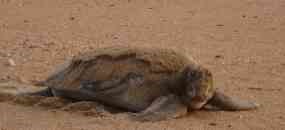
NPS Common Name: Green sea turtle, named for the green color of the fat under its shell. Scientific Name: Chelonia mydas Description: The head is small and blunt with a serrated jaw. The color of the top shell varies from pale to very dark green and plain to very brilliant yellow, brown and green with radiating stripes. The bottom shell ranges from white to yellowish. All flippers have 1 visible claw. Green’s can be distinguished from all other sea turtles by the single pair of scales on the front of the head. Hatchlings are dark brown, but become much paler by the age of 6 months. Size: Diet: Changes significantly during its life. When less than 8 to10 inches in length, they eat worms, young crustaceans, aquatic insects, grasses, and algae. Once green’s reach 8-10 inches in length, they mostly eat sea grasses and algae. Green’s are the only species of sea turtle that is strictly herbivorous as an adult. Their jaws are finely serrated which aids them in tearing vegetation. Habitat: Greens are found mainly near the coastline in shallow, sandy flats covered with seagrasses or in areas where seaweeds can be found. Scattered rocks, bars, and corals are used as nighttime sleeping sites. They are rarely observed in the open ocean. Nesting: Greens nest at intervals of 2, 3, or more years, with a wide year-to-year fluctuations in numbers of nesting females. They can nest between 1 to 7 times per season, approximately 12 to 14 days apart. Each nest can contain between 100 to 120 eggs. Incubation can take between 30 to 90 days. The Cape Hatteras National Seashore is at the extreme northern limit for nesting. Range: The green sea turtle is found in parts of the Atlantic, Pacific and Indian Oceans, primarily in the tropics. Status: Population Estimate: around 88,520 nesting females (male population numbers are unknown). |
Last updated: August 30, 2023
